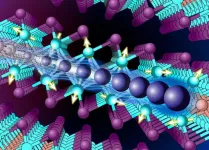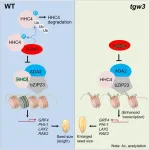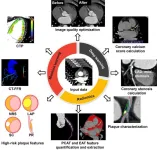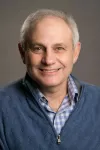(Press-News.org) Researchers at Columbia University have successfully synthesized the first 2D heavy fermion material. They introduce the new material, a layered intermetallic crystal composed of cerium, silicon, and iodine (CeSiI), in a research article published today in Nature.
Heavy fermion compounds are a class of materials with electrons that are up to 1000x heavier than usual. In these materials, electrons get tangled up with magnetic spins that slow them down and increase their effective mass. Such interactions are thought to play important roles in a number of enigmatic quantum phenomena, including superconductivity, the movement of electrical current with zero resistance.
Researchers have been exploring heavy fermions for decades, but in the form of bulky, 3D crystals. The new material synthesized by PhD student Victoria Posey in the lab of Columbia chemist Xavier Roy will allow researchers to drop a dimension.
“We’ve laid a new foundation to explore fundamental physics and to probe unique quantum phases,” said Posey.
One of the latest materials to come out of the Roy lab, CeSiI is a van der Waals crystal that can be peeled into layers that are just a few atoms thick. That makes it easier to manipulate and combine with other materials than a bulk crystal, in addition to possessing potential quantum properties that occur in 2D. “It’s amazing that Posey and the Roy lab could make a heavy fermion so small and thin,” said senior author Abhay Pasupathy, a physicist at Columbia and Brookhaven National Laboratory. “Just like we saw with the recent Nobel Prize to quantum dots, you can do many interesting things when you shrink dimensions.”
With its middle sheet of silicon sandwiched between magnetic cerium atoms, Posey and her colleagues suspected that CeSiI, first described in a paper in 1998, might have some interesting electronic properties. Its first stop (after Posey figured out how to prepare the extremely air-sensitive crystal for transport) was a Scanning Tunneling Microscope (STM) in Abhay Pasupathy’s physics lab at Columbia. With the STM, they observed a particular spectrum shape characteristic of heavy fermions. Posey then synthesized a non-magnetic equivalent to CeSiI and weighed the electrons of both materials via their heat capacities. CeSiI’s were heavier. “By comparing the two—one with magnetic spins and one without—we can confirm we’ve created a heavy fermion,” said Posey.
Samples then made their way across campus and the country for additional analyses, including to Pasupathy’s lab at Brookhaven National Laboratory for photoemission spectroscopy; to Philip Kim’s lab at Harvard for electron transport measurements; and to the National High Magnetic Field Laboratory in Florida to study its magnetic properties. Along the way, theorists Andrew Millis at Columbia and Angel Rubio at Max Planck helped explain the teams’ observations.
From here, Columbia’s researchers will do what they do best with 2D materials: stack, strain, poke, and prod them to see what unique quantum behaviors can be coaxed out of them. Pasupathy plans to add CeSiI to his arsenal of materials in the search for quantum criticality, the point where a material shifts from one unique phase to another. At the crossover, interesting phenomena like superconductivity may await.
“Manipulating CeSiI at the 2D limit will let us explore new pathways to achieve quantum criticality,” said Michael Ziebel, a postdoc in the Roy group and co-corresponding author, “and this can guide us in the design of new materials.”
Back in the chemistry department, Posey, who has perfected the air-free synthesis techniques needed, is systematically replacing the atoms in the crystal—for example, swapping silicon for other metals, like aluminum or gallium—to create related heavy fermions with their own unique properties to study. “We initially thought CeSiI was a one-off,” said Roy. “But this project has blossomed into a new kind of chemistry in my group.”
END
Columbia chemists create the first 2D heavy fermion
The layered crystal, CeSiI, with heavier-than-normal electrons is a new platform to explore quantum phenomena.
2024-01-17
ELSE PRESS RELEASES FROM THIS DATE:
Therapy versus medication: comparing treatments for depression in heart disease
2024-01-17
New research by investigators from the Department of Psychiatry and Behavioral Neurosciences at Cedars-Sinai shows that behavioral activation therapy is as effective as antidepressant medications in treating symptoms of depression in patients with heart failure.
Heart failure affects nearly 6 million adults in the United States, and approximately 50% of heart failure patients experience symptoms of depression along with their condition. Past studies show patients with heart failure and depression have lower cardiac function, more emergency department ...
Active membranes: The future of fresh water is bright
2024-01-17
The growth of Los Angeles as a startup hub is highlighted by a robust and diverse entrepreneurial ecosystem within UCLA. The Magnify Incubator at CNSI is no exception to showcasing the range of early-stage businesses.
One such company within the Magnify incubator, Active Membranes, is innovating the future of fresh water through membrane desalination. As freshwater is becoming increasingly scarce around the globe, resources such as seawater and industrial wastewater are costly to procure and operate. The company’s patented technology is electrically conducting ...
What’s stopping US climate policies from working effectively
2024-01-17
In an effort to reduce greenhouse gas emissions and curb global warming, the U.S. has enacted several ambitious federal laws, such as the Inflation Reduction Act (IRA) passed in 2022 and the Infrastructure Investment and Jobs Act (IIJA) of 2021.
These provide significant investments in clean energy projects and encourage technological innovations. Some analyses suggest they could reduce greenhouse gas emissions by more than 40% below 2005 levels by 2030.
However, in a paper published Jan. 16 in the journal Nature Climate Change, researchers at the University ...
Chromatin modifier-centered pathway points to higher crop yield
2024-01-17
Chromatin is the complex of DNA and proteins that makes up the genetic material in the nucleus of eukaryotic cells. A chromatin modifier is a protein or complex of proteins that chemically modifies the structure of chromatin. Chromatin modifiers play a crucial role in regulating the expression of genes, which are segments of DNA strands, as well as in other chromatin-related processes. These modifiers mainly work by adding or subtracting chemical groups to histones, a type of protein within the chromatin, or to the DNA itself.
In the scientific effort to manipulate the expression of plant genes, such as for grain size or drought-resistance, etc., understanding the influence ...
U.S. voters’ climate change opinions swing elections
2024-01-17
When voters cast their ballots in the 2016 and 2020 presidential elections, many were driven by their concern for climate change, according to new research out of CU Boulder’s Center for Environmental Futures (C-SEF). The new report determined that views on climate change played a significant role in whom people voted for, concluding that the climate issue very likely cost Republicans the 2020 election, all else equal.
“This is obviously information that politicians and advocates across the political spectrum will want to know, heading into the 2024 election cycle,” said Matthew Burgess, CIRES Fellow and C-SEF director. “How ...
Artificial intelligence helps coronary CT angiography and accelerates the development of precision medicine
2024-01-17
This review was jointly published by Prof. Long-Jiang Zhang (Department of Radiology, Jinling Hospital, Affiliated Hospital of Medical School, Nanjing University) and Prof. Christian Tesche (Division of Cardiovascular Imaging, Department of Radiology and Radiological Science, Medical University of South Carolina and Department of Cardiology, Munich University Clinic, Ludwig-Maximilian-University).
With the continuous progress of science and technology, artificial intelligence (AI) has become an important driving force for a new round of scientific and technological revolution and industrial change. It aims to mimic human consciousness and thought processes, continuously ...
New research finds half-cardio, half-strength training reduces cardiovascular disease risks
2024-01-17
AMES, Iowa — Approximately one in three deaths in the U.S. is caused by cardiovascular disease, according to the U.S. Centers for Disease Control and Prevention. A robust body of evidence shows aerobic exercise can reduce risks, especially for people who are overweight or obese. But few studies have compared results with resistance exercise — also known as strength or weight training — or with workout regimens that are half aerobic and half resistance. Researchers at Iowa State University led one of the longest and largest supervised exercise trials to ...
ECOG-ACRIN Cancer Research Group melanoma research team led by Michael Atkins, MD, receives the 2023 Paper of the Year distinction from the Journal of Clinical Oncology
2024-01-17
A team of melanoma researchers with the ECOG-ACRIN Cancer Research Group (ECOG-ACRIN) is honored with the 2023 Paper of the Year distinction by the Journal of Clinical Oncology. The recognition is for the results of the DREAMseq randomized phase 3 clinical trial. DREAMseq (EA6134) showed an optimal treatment sequence for combination therapy in patients with advanced melanoma with a BRAFV600 tumor gene mutation. The treatment sequence beginning with immunotherapy (nivolumab and ipilimumab), followed by targeted therapy (dabrafenib and trametinib) if there was disease progression, resulted ...
The American Journal of Clinical Nutrition launches new article series to educate physicians and other health care professionals on nutrition
2024-01-17
Rockville, MD (January 16, 2024) – To educate physicians and other health care professionals on the fundamentals of nutrition, The American Journal of Clinical Nutrition has launched a new article series titled Nutrition for the Clinician. The effort supports the White House National Strategy on Hunger, Nutrition, and Health and its directives to expand nutrition knowledge of health care providers, an effort long supported by the American Society for Nutrition. Nancy Krebs, MD, MS, Professor of Pediatrics, University of Colorado ...
New research shows that most early galaxies looked like breadsticks rather than pizza pies or dough balls
2024-01-17
Columbia researchers analyzing images from NASA’s James Webb Space Telescope have found that galaxies in the early universe are often flat and elongated, like breadsticks—and are rarely round, like balls of pizza dough. “Roughly 50 to 80% of the galaxies we studied appear to be flattened in two dimensions,” explained Viraj Pandya, a NASA Hubble Fellow at Columbia University, and the lead author of a new paper slated to appear in The Astrophysical Journal that outlines the findings. “Galaxies that look like long, thin breadsticks seem to be very common in the early universe, which is surprising, since they are uncommon among galaxies ...
LAST 30 PRESS RELEASES:
First Editorial of 2026: Resisting AI slop
Joint ground- and space-based observations reveal Saturn-mass rogue planet
Inheritable genetic variant offers protection against blood cancer risk and progression
Pigs settled Pacific islands alongside early human voyagers
A Coral reef’s daily pulse reshapes microbes in surrounding waters
EAST Tokamak experiments exceed plasma density limit, offering new approach to fusion ignition
Groundbreaking discovery reveals Africa’s oldest cremation pyre and complex ritual practices
First breathing ‘lung-on-chip’ developed using genetically identical cells
How people moved pigs across the Pacific
Interaction of climate change and human activity and its impact on plant diversity in Qinghai-Tibet plateau
From addressing uncertainty to national strategy: an interpretation of Professor Lim Siong Guan’s views
Clinical trials on AI language model use in digestive healthcare
Scientists improve robotic visual–inertial trajectory localization accuracy using cross-modal interaction and selection techniques
Correlation between cancer cachexia and immune-related adverse events in HCC
Human adipose tissue: a new source for functional organoids
Metro lines double as freight highways during off-peak hours, Beijing study shows
Biomedical functions and applications of nanomaterials in tumor diagnosis and treatment: perspectives from ophthalmic oncology
3D imaging unveils how passivation improves perovskite solar cell performance
Enriching framework Al sites in 8-membered rings of Cu-SSZ-39 zeolite to enhance low-temperature ammonia selective catalytic reduction performance
AI-powered RNA drug development: a new frontier in therapeutics
Decoupling the HOR enhancement on PtRu: Dynamically matching interfacial water to reaction coordinates
Sulfur isn’t poisonous when it synergistically acts with phosphine in olefins hydroformylation
URI researchers uncover molecular mechanisms behind speciation in corals
Chitin based carbon aerogel offers a cleaner way to store thermal energy
Tracing hidden sources of nitrate pollution in rapidly changing rural urban landscapes
Viruses on plastic pollution may quietly accelerate the spread of antibiotic resistance
Three UH Rainbow Babies & Children’s faculty elected to prestigious American Pediatric Society
Tunnel resilience models unveiled to aid post-earthquake recovery
Satellite communication systems: the future of 5G/6G connectivity
Space computing power networks: a new frontier for satellite technologies
[Press-News.org] Columbia chemists create the first 2D heavy fermionThe layered crystal, CeSiI, with heavier-than-normal electrons is a new platform to explore quantum phenomena.




